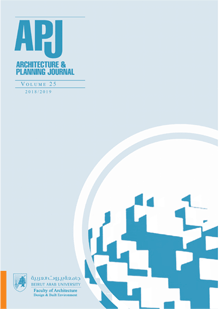Volume 30, Issue 1 (2024)
IBRAHIM MAAROUF - Professor, Department of Architectural Engineering, Faculty of Engineering, Alexandria University
The Architecture and Planning Journal of the Beirut Arab University boldly strides into third millennium, pioneering a successful approach to scientific publishing standards. It stands shoulder to shoulder with the giants of the publishing world, excelling in its rankings through the calibre of its research contributions and the refinement of its academic standards. Spearheading advancements in scientific and research endeavours across the Middle East, it emerges from the rich tapestry of Lebanese, Arab, and Mediterranean societies to claim a prestigious position among esteemed scholarly journals.
In this issue (Volume 30, Issue 1) the Journal persists in its commitment to excellence within the realms of planning and architecture. It offers a substantial contribution to readers and academic researchers by exploring various concepts within the context of the changing urban and built environments globally. These studies bravely navigate both areas, seeking innovative uses of technology, especially electronic technologies. They delve into the realm of computing in all its facets and developments, examining its indicators, motivations, and the factors paving the way for its application in the fields of architecture and urban planning.
This issue includes a collection of research papers, whether individual or collaborative, comprising seven studies all focused on the concept of sustainability and integrated urban environments. The papers reinforce these concepts through technological foundations, discussing parametric studies at times and information technology, such as Geographic Information Systems (GIS), at others. This also encompasses discussions on Building Information Modelling/Management (BIM). This progression is clearly delineated through the seven research papers as follows:
- The main objective of the first paper is to propose a sustainable strategy for the regeneration of Port Said's waterfront, addressing urban, economic, environmental, and social aspects while preserving its heritage and historical significance.
- This paper explores a design approach integrating parametric methods and simulations to create sustainable solutions for outdoor solar parametric shades in hot arid zones. It outlines a methodology using parametric modelling, genetic algorithms, and environmental analysis tools to optimize thermal comfort in urban areas.
- Restoring the cultural heritage identity of Tripoli's Abu Ali River area, which has faced neglect and loss of identity. By creating a cultural park in leftover spaces, it seeks to rejuvenate this historical zone. The paper details a process involving theoretical research, case studies, area analysis, and design application.
- Enhancing computer generative design tools by updating the 'SYNTCATIC v-2.7' plug-in to include factors like horizontal circulation in residential buildings. It simplifies zoning optimization and design exploration, empowering architects to make informed decisions more effectively.
- This paper develops an innovative tool for conserving historical buildings sustainably by integrating BIM and GIS. It facilitates decision-making in material selection and intervention, focusing on an open-source model with a case study in Beirut's Armenia Street. It emphasizes civil society involvement and the social and economic benefits of sustainable urban heritage management.
- This paper aims to enhance wayfinding in Abuja's shopping malls. Studying three malls, it emphasizes clear spatial organization for easier navigation, recommending linear floor plans and prominent visual cues. Suggestions include designing user-friendly spaces with clear signage and landmarks.
- Assesses walkability efficiency in Saudi cities using DEA to improve urban liveability. Efficient cities like Makkah and Riyadh are identified, while Abha and Taif need improvement. Insights are provided for strategic urban planning to enhance overall sustainability.
Drawing from the aforementioned points, it becomes increasingly apparent the significance and pivotal role played by the articles emanating from Architecture and Planning Journal, Beirut Arab University within the realms of architecture and urban planning. Its collaboration with international publishers and its advancement in rankings through its outstanding research showcased in this issue. It reaffirms its commitment to technological concepts, sustainability, and development, principles emphasized by the United Nations for nearly seven years. The United Nations continues to seek reaffirmation of these concepts, their foundations, and their support in various urban and architectural communities.
URBAN WATERFRONT REVITALIZATION AS A REGENERATIVE TOOL OF SUSTAINABLE CITIES
Nora M. Rehan
Article Language: English
PARAMETRIC DESIGN AS A TOOL TO REDUCE SOLAR PENETRATION BY OUTDOOR SHADES IN HOT ARID CLIMATE
Rana O. Aboulfaraj, Iman O. Gawad, and Mostafa Khalifa
Article Language: English
BIM-GIS INTEGRATION AN INNOVATIVE TOOL TO ENHANCE URBAN HERITAGE MANAGEMENT IN THE DIGITAL ERA
Ali H. Misilmani, Ibtihal Y. El-Bastawissi, Hany Ayad, and Samer El Sayary
Article Language: Arabic
EXPLORING SPATIAL CONFIGURATION FOR EFFECTIVE WAY-FINDING IN THE DESIGN OF SHOPPING MALLS IN ABUJA - NIGERIA
Jephthah I. Aigbe, Joy J. Maina, and Musa L. Sagada
Article Language: English
GENERATING A DESIGN AUTOMATION FOR FUNCTIONAL RELATIONSHIP IN RESIDENTIAL BUILDING: DEVELOPING PLUG IN
Fatima Yahya Belok, Mostafa Khalifa, and Nabil Mohareb
Article Language: English
REVIVING CULTURAL HERITAGE IDENTITY IN HISTORICAL AREAS THROUGH LEFTOVER SPACES – APPLICATION OF A CULTURAL PARK IN ABU ALI RIVER REGION, TRIPOLI, LEBANON
Amna Trad, Mostafa Khalifa, Eslam M. Elsamahy, Khaled El-Daghar, Mary Felix, and Ayman Afify
Article Language: English


